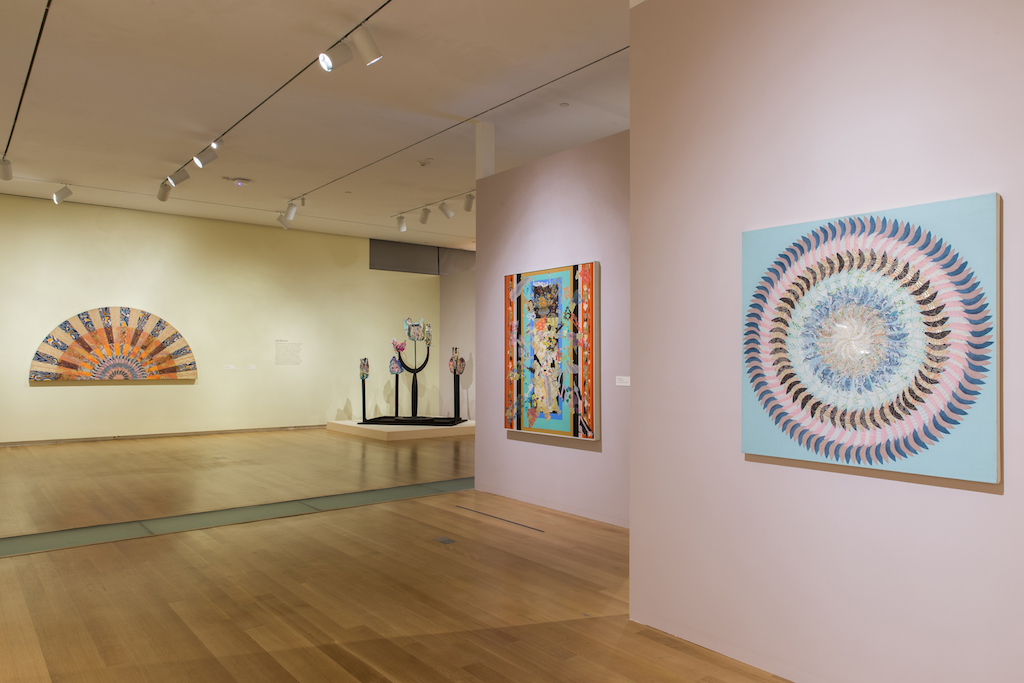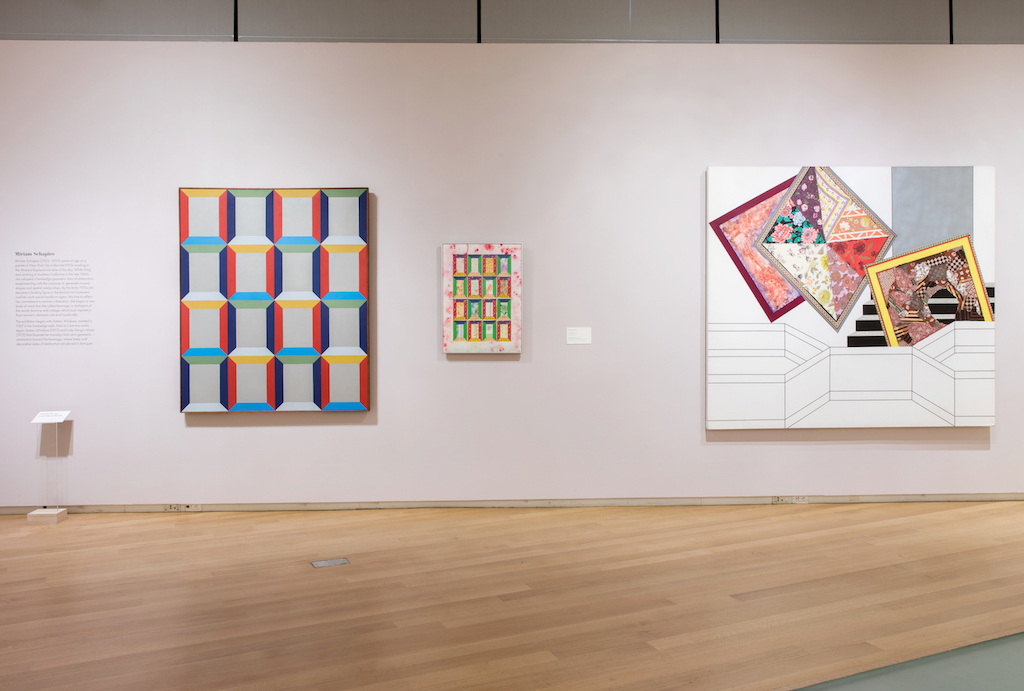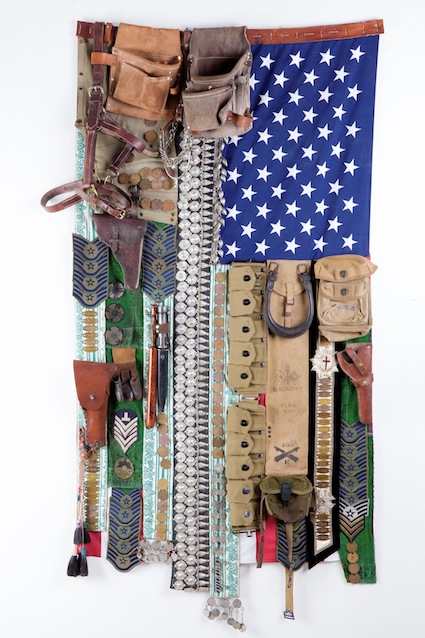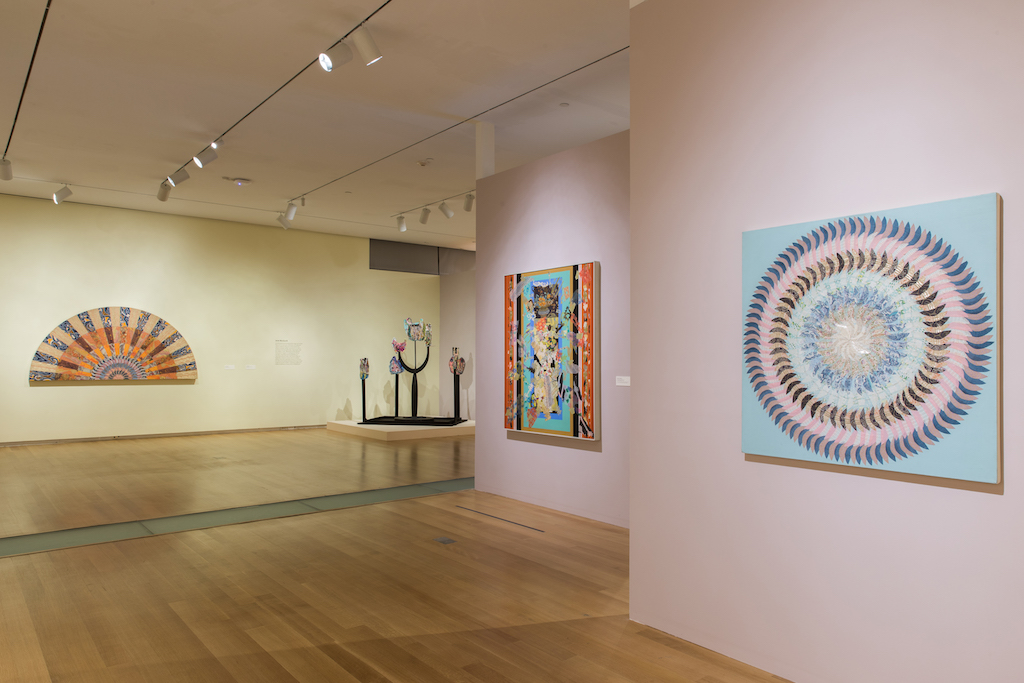[ad_1]

Installation view of “Surface/Depth: The Decorative After Miriam Schapiro,” 2018, at the Museum of Arts and Design, New York.
JENNA BASCOM/COURTESY MUSEUM OF ARTS AND DESIGN
In a 1989 interview, the artist Miriam Schapiro discussed her admiration for “heroines” like Virginia Woolf, Sylvia Plath, and Frida Kahlo. Noting their rather fraught lives, she said “that doesn’t stop you from expressing your point of view in whatever manner you choose to do it.” In the 1970s, Schapiro herself chose to make craft works that she termed “femmages” (a portmanteau of “feminine” and “collage”), which staked a claim for women, both in the art world and outside it, by centering the home as a site of resilience and subversion. And she certainly lived by these principles of resistance, deliberately situating her practice against artistic norms of her day.
For years, Schapiro’s work was relegated to relative obscurity compared with that of many of her male contemporaries. But since her death in 2015, and following a retrospective at the National Academy Museum in New York the year after, her art has been reappraised, and is a key inspiration for a number of artists working today. A new exhibition at the Museum of Arts and Design in New York, “Surface/Depth: The Decorative After Miriam Schapiro,” offers an vigorous look at the feminist pioneer’s work, placing it alongside pieces by nine contemporary artists and a selection of personal objects from the Schapiro estate.
“Surface/Depth” brings to life a phantasmagorical world in which psychedelic patterns dance on televisions wrapped in vibrantly colored paper and canvases teem with multicolored flowers. Both Schapiro and the artists she influenced demonstrate the many ways craft works—collages, quilts, and even plastic bags—can become useful, critical tools for investigating social and political structures.
One of the main goals of “Surface/Depth” was to place craft—long marginalized by some critics—on the same level as painting, sculpture, and installation, Elissa Auther, the show’s curator, told ARTnews. Historically, she said, craft’s “dismissal” by art historians is “directly related to the ways we think of the female body as a decorative accessory or the body as surface, as cosmetic, as false. And those are all related to the broader dismissal of women as actors in the world.”
Auther has long prioritized working with feminist artists. In 2009, she published the book String, Felt, Thread: The Hierarchy of Art and Craft in American Art, which called into question many writers’ negative attitudes toward the decorative arts, and Schapiro figured prominently in a chapter on feminist art. When Auther returned to Schapiro’s work for this exhibition, she wanted to situate it among contemporary pieces by artists “who were deeply engaged with the conversation that she initiated,” she said, all the while acknowledging the more varied political and social concerns of those works.
Whereas Schapiro was concerned more broadly with women’s experiences in the domestic sphere, the other artists in the show—Sanford Biggers, Josh Blackwell, and Sara Rahbar among them—are grappling with issues related to race, gender, sexuality, the U.S.’s actions in the Middle East, and more.
Schapiro was, herself, a radical, a leader of the Pattern and Decoration Movement of the 1970s and, along with artist Judy Chicago, a founder of Womanhouse, the feminist art space active in 1972 in Los Angeles. Also with Chicago, Schapiro established the first feminist art program, at CalArts. As art historian Jenni Sorkin writes in her 2007 essay “The Feminist Nomad: The All-Women Group Show,” all-women exhibitions, collectives, and spaces “were a direct response to the widespread absence of women artists’ work from museums and public culture at large.”

Installation view of “Surface/Depth: The Decorative After Miriam Schapiro,” 2018, at the Museum of Arts and Design, New York.
JENNA BASCOM/COURTESY MUSEUM OF ARTS AND DESIGN
Before becoming a major figure in the feminist art scene, Schapiro worked within the language of Minimalism, and “Surface/Depth” features rare examples of her subdued early style. The exhibition’s earliest piece, Silver Windows (1967), shows 16 silver rectangles, all of them enclosed within painted frames, arranged in a pattern based on color scheme. The paintings Again Sixteen Windows (1973) and Lady Gengi’s Maze (1972) are similarly cold and precise in their means, though these works have a dash of the vivacity and excess that would soon come to define her practice, presenting bright, disparate patterns in increasingly chaotic arrangements.
The remaining 26 Schapiro works in the show—all “femmages”—are joyfully garish amalgams of colors, materials, subjects, and tones. The checkerboard composition of Connection (1978) recalls patchwork quilts, while Explode (1972) exudes a sense of chaos and messiness befitting its title. The Beauty of Summer (1973–74) brims with countless floral motifs, evoking the warmth of its titular season.

Miriam Schapiro, The Beauty of Summer, 1973–74, acrylic, fabric on canvas.
©MIRIAM SCHAPIRO/ARTISTS RIGHTS SOCIETY (ARS), NEW YORK/COURTESY ERIC FIRESTONE GALLERY

Sara Rahbar, Flag #4 Champions, 2006–13, mixed media.
COURTESY THE ARTIST AND CARBON 12
These works are interspersed with those by the contemporary artists, who offer various updates of Schapiro’s signature style. Edie Fake’s drawings, part of a series called “Memory Palaces,” depict architectural facades and doorways; according to the artist, the works represent his “queer neighborhood” in Chicago. (These places have been invented by Fake, or have been demolished or coopted in the physical world.)
Sara Rahbar’s “Flag” series addresses tensions between the U.S. and the Middle East. The artist layered American military paraphernalia and Middle Eastern textiles onto the stars and stripes, calling attention to the army’s intervention in the region. With layers and combinations of patterns and materials, these compositions nod to Schapiro’s style. Additionally, the imaginative qualities of these pieces—Fake’s invention of places that never physically existed, Rahbar’s reinterpretation of a nationalistic symbol—recall Schapiro’s ability to find political and emotional connections in fabrics, shapes, and found materials.
There’s been a turn toward craft in the contemporary art world, and Auther noted that she could have curated “Surface/Depth” three times over. “We’re almost at a high point of interest in the decorative,” she said, adding that this general resurgence of interest in the decorative arts is, in part, due to the rise of artisanal lifestyle choices involving home decor, food, and drink.
“People are much more comfortable with understanding themselves as creative people [today], even if they don’t label themselves as artists or they’re not practicing as professional artists,” Auther said. “Everyone feels like they have something to offer when it comes to creative practice, which I think was, in [Schapiro’s] time, much more limited to the professional artists. That’s an amazing kind of cultural phenomenon, that we all think of ourselves as creative people.”
[ad_2]
Source link

